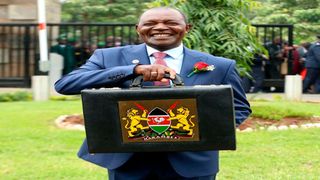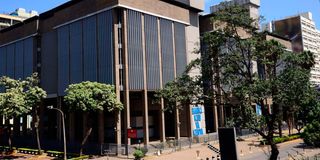
National Treasury Cabinet Secretary Njuguna Ndung’u at Parliament Buildings for the reading of the 2023/24 Budget Statement on June 15, 2023.
| Sila Kiplagat | Nation Media GroupWeekly Review
Premium
Ruto’s Budget blunders: Why proposals will dash economic recovery, stifle growth
Theo’s Budget: A friend regaled me weeks ago with Bill Cosby’s 2009-episode, Theo’s Budget, or Economics 101. It details a father’s budgetary lesson to his not-so-ambitious son, evading college for the low-paying life of ‘regular people’.
The father, offering US$1,200 pocket money, opens his son’s eyes to the realities of income and taxation in a mock game of cards using US$ notes. First, he snatches $350 for taxes, saying, “the government comes for the regular people first”.
The son is left with $200 after all the deductions and watches his father snatch even that, “and you haven’t eaten yet”. Just as Theo runs out of tarmac, Kenya’s budget debates reminded me of a famed Gĩkũyũ cautionary saying for those who do not heed advice: Mũrega akĩrwo ndaregaga akĩhetwo (he who rejects advice, shouldn’t blame anyone for his failures).
No one can begrudge the government mandarins their hard work on an economy teeming with distortions. Disappointingly, the government never gets the memo: Red ink in public finances costs the nation dearly, just as corruption eats it from within.
Cosby’s parenting resonates with the 2023-24 budget. Many struggle to eat, and the carpet of poverty spreads nationwide while budgets disregard economic tools for a plummeting economy. Wrong-footed and without rhyme or reason, the budget is defined by the headline flaw of an impoverishing macroeconomic policy mix that tightens both sides: The fiscal side increases taxes but only half-heartedly controls government spending. President William Ruto’s government itself remains a big spender. For a fiscal deficit of KSh718 billion (4.4 per cent of GDP) including grants, external borrowing is scaled back sharply to KSh131.5 billion (0.8 per cent of GDP), leaving domestic borrowing of KSh586.5 billion (3.6 per cent of GDP).

The Central Bank of Kenya building in Nairobi.
On the monetary side, the CBK’s new leadership had hardly taken their seats before signalling the highest costs of borrowing since 2015, which will slow economic growth. The governor and the Monetary Policy Committee swung a policy interest rate of 10.5 per cent, along with earlier misadventures in controversial monetary policy tinkering to issue bonds for US dollars – wait a minute for this.
The combined fiscal/monetary tightening stance ignores the macroeconomics of aligning Kenya’s business cycle to appropriate headline macro-policy to propel sustainable growth. In sum, the double tightening contracts the economy while growth is the only path out of the current slump. Appropriate macro-choices exist that work forcefully in charting economic recovery.
Coherence elusive
Fiscal policy smooths taxation over time (effecting transfers and distributive effects among households and sectors), with strong and direct influences on aggregate demand and acting through variations in spending and a metric called the fiscal multiplier. Counterpart monetary policy also affects transfers, but differently: For example, among creditors, credit shares to government and private sector, returns to banks, and players in the securities market.
While central banks primarily regulate financial markets and target inflation through money creation, the optimal fiscal/monetary policy mix sets the stage in an interaction that affects prospects for short-to-medium-term and long-run growth.
With the appropriate mix, a rise in output brings huge payoffs in external balances, fiscal sustainability, lower deficits, employment and inflation control. Currently, fiscal sustainability as the elephant in the room poses severe sovereign debt risks and erosion of confidence among investors, which will persist until we upgrade our aspirations.
President Bill Clinton over 1991-1998 best demonstrated the power of coherent policy mix, taking power under the cloud of the 1990-91 US recession. In his tough macro-policy mix choices, he addressed the second highest fiscal deficit (4.5 per cent of GDP) in the US since WW2, working with Federal Reserve Chairman Allan Greenspan to trigger the turnaround of a scenario akin to Kenya’s today. A tight fiscal stance was implemented simultaneously with an expansionary monetary policy. Interest rates went down from 7.3 per cent in 1991 to 3.3 per cent in 1994 and the US regained prosperity.
In contrast, Kenya’s President may be grossly misadvised to tolerate flawed policy choices. A double tightening will see both sides of policy fail together, and fail Kenyans by contracting the economy. One might even argue that in 21st Century economic management, little else works outside of the headline lessons of complementarity and adoption of appropriate policy mix under several applicable scenarios influencing households and the sectors, triggering the desired directions of the mix to achieve economic sustainability.
Fiscal deficits
To understand the standard policy interests of the National Treasury and the CBK that need coordination, the former looks to enjoy access to borrowing to address its fiscal deficits, while the CBK should look to regulate the lending and risk-taking behaviour of financial intermediaries and financial market participants to tame and monitor inflationary and exchange rate outcomes of fiscal spending.
Kenya has only ever successfully applied this model during the time of President Mwai Kibaki, from 2002-2013. He moved GDP growth from 0.5 per cent to 8.4 per cent by 2010, cutting both fiscal spending and borrowing of domestic debt; combining increased taxation with efficiency of tax administration; reducing public debt from 64.1 per cent of GDP to 38 per cent; and eventually financing about 90 per cent of the budget from Kenya’s own revenues. In economics, this involved shifting the IS (investment-saving) curve to the left and LM (liquidity preference-money supply) curve to the right to achieve higher growth.
The 2023/24 combination, the first by the new regime, will predictably and vigorously dash economic recovery and growth in a misapplication that has yielded dismal results around the world. It will contract growth, revenues the Kenya government expects to collect, and stoke job cuts, poverty, and inflation.
Government in the 2023/24 budget instead prioritises its own operational spending (including funding Prayer Breakfasts, not to mention collusive bleeding of the veins of the economy via corruption) and offtakes for debt repayments in place of a two-punch deficit reduction plan on the fiscal side – tax increases and spending cuts – while the CBK needs to lower interest rates to revive private sector economic activity.
This would switch economic activity to the private sector, paying off in investment, growth, employment, revenue collection and funding to tame our public debt mountain.
The tax raids to fund government business will trigger extreme contraction of economic activity leading, as in Theo’s budget, to economic underperformance and the narrow prospects of Theo’s ‘ordinary people’.
Ironically, no sector faces prospects as bleak as agriculture, where the majority of the population (hustlers) subsist at the bottom of the pyramid, and where Kenya’s key exports originate.
The graph above maps the linear trend decline in budgetary shares in allocations to agriculture from Ordinary Revenues compared to recent years of budgetary proposals, where Ordinary Revenues rose in percentage allocations from KSh1,594.0 billion (3.3 per cent) in 2020/21, peaked at KSh1775.6 billion (4.3 per cent) then fell thereafter to the current projected KSh2.57 trillion (1.9 per cent) for 2023/24.
In effect, none of the populist promises for the ‘ordinary people’ – such as the Hustler Fund or affordable housing – will revive growth under the erroneous policy mix. Housing pointedly comes at the expense of a new tax on the small proportion of Kenya’s labour-force engaged in salaried activities, as well as their employers. The vaunted ‘bottom-up’ construct also comes last in agriculture, which supports most of the Kenyan population.
Brinkmanship or weak policies?
The effects of an inappropriate policy mix are predictable. Already, its classic results of failure of economic management are emerging, with the CBK hogging much of the distortion. A ballooning public debt is stoking a debasement of public debt and investor pricing of risks, side-stepping longer-dated lending to government in securities and looking to premiums to evade haircuts.
The uptick in the cost of credit at the CBK risks impeding recovery in other dimensions. Little of the interest rate hikes trickle down to savers on the liabilities side of commercial bank balance sheets.
As the CBK oversees commercial banking regulations and also acts as government’s fiscal agent, an interesting twist emerges on how far it will go to whet government appetite for borrowing the massive amounts in the KSh586.5 billion 2023/24 budget, which is 3.6 per cent of GDP, without risking credibility of its monetary policy along with financial stability.
Two points illustrate the dilemma: results of the Seven-Year Treasury Bond Issue No. IFB1-2023-007 dated 19-06-2023 offered gross rates (inclusive of tax exemptions) calculated at about 20-22 per cent.
This rewards financial support of government borrowing over lending to the real economy. Not just that; it sets a puzzle as to how credible it is, and to whom the official 10.5 per cent MPC rate of June 26 was issued. The rate of June 19, 2023, showed a surprise KSh220 billion costly offering.
Furthermore, the governor, before assumption of duty, offered ideas on a domestic clone of borrowing dollars domestically from the commercial banks by bond issuance. That would contract money supply, raise interest rates and cause market chaos in key parts of Kenya’s monetary base (currency in circulation plus reserves). Effectively, a bond for US$ with augmented returns to holders would be a subsidy paid for with taxpayer funds. Forgive me for the sense of alarm akin to that of the exiting CBK governor.
Dr Wagacha, an economist, is a former Central Bank of Kenya chairman and adviser of the Presidency




